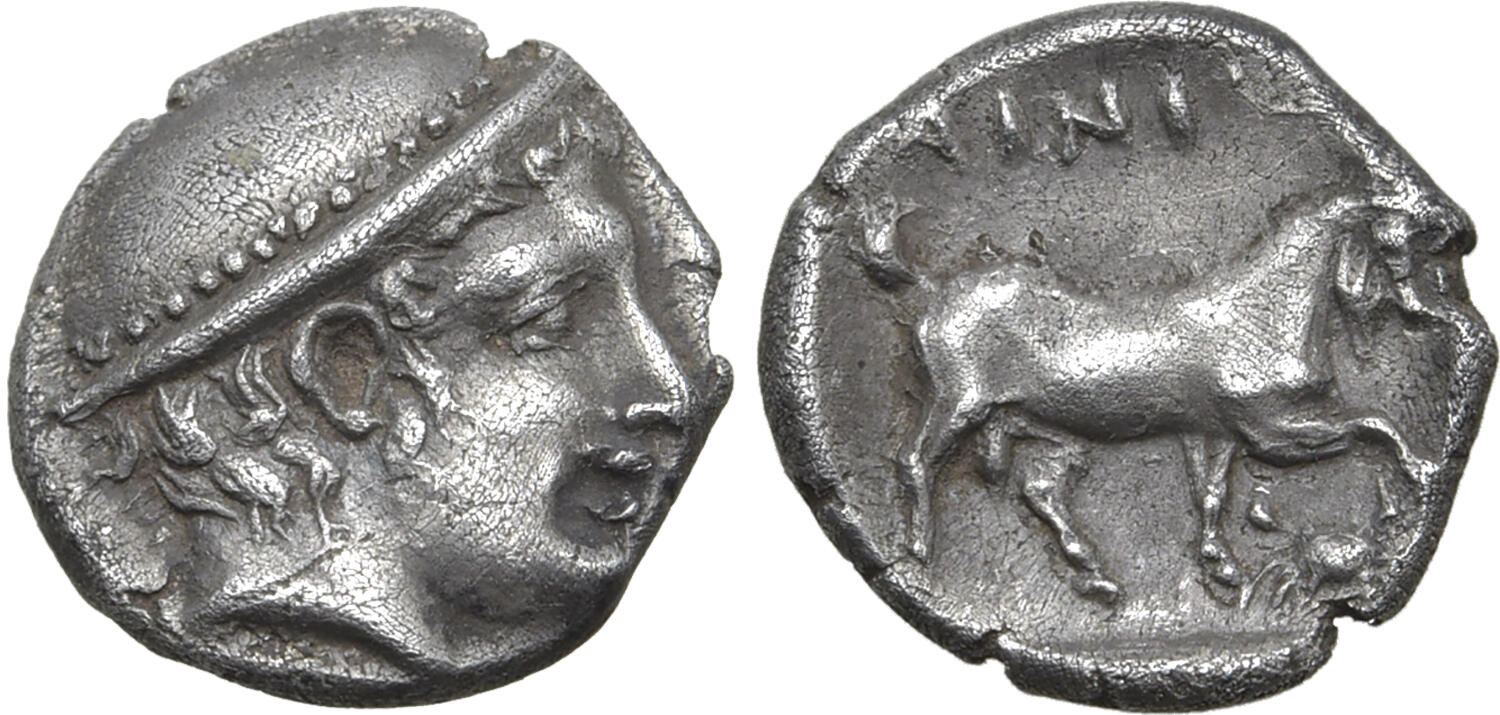AC 112 - Aenus, silver, diobols (469/8-406/5 BCE)
From SILVER
469 BCE - 405 BCE Silver 4,810 kg
Description
| ObverseInscription or printing placed on the obverse.: | Head of Hermes to right, wearing petasos |
| ReverseInscription or printing placed on the reverse.: | AINI (Greek).Goat walking to right, AINI above. |
Mint and issuing power
| MintIdentifies the place of manufacture or issue of a numismatic object.: | Aenus | Ancient regionAncient region.: | Thrace | Modern countryModern country: Greece | AuthorityIdentifies the issuing power. The authority can be "pretended" when the name or the portrait of X is on the coin but he/she was not the issuing power. It can also be "uncertain" when there is no mention of X on the coin but he/she was the issuing power according to the historical sources: |
Chronology
| FromIdentifies the initial date in a range assigned in a numismatic context. | 469 BCE | toIdentifies the final date in a range assigned in a numismatic context.. | 405 BCE | PeriodTime period of the numismatic object.: Classical 480-323 BC |
Physical description
| MetalThe physical material (usually metal) from which an object is made.: | Silver |
Median weightMedian of the weights of numismatic objects (in grams). in grams | 1.30 | DenominationTerm indicating the value of a numismatic object. Examples: tetradrachm, chalkous, denarius.: | diobol |
StandardStandard.: |
Image

AC112 Aenus.jpeg [1]
References
| Die study referencePublication of the study: | May 19501May 1950 | ||
| Coin series referenceReference to coin series study: | RQEMAC2RQEMAC, n° 112 | ||
Obverse dies distribution
| FrequencyFrequency of specimen in distribution. ᵖ | Number of obversesNumber of obverse dies. ᵖ (o) | % (o) | Number of coinsNumber of coins. (n) | % (n) | Die nameName(s) of the die(s). |
| 1 | 58 | 44.27 | 58 | 18.13 | 11, 12, 13, 14, 19, 20, 21, 24, 26, 36, 38, 39, 40, 41, 42, 48, 50, 52, 53, 64, 65, 67, 70, 71, 72, 77, 83, 87, 91, 94, 96, 103, 104, 110, 112, 113, 115, 117, 119, 121, 123, 124, 127, 129, 132, 137, 138, 139, 140, 141, 147, 148, 172, 175, 177, 191, 192, 195 |
| 2 | 28 | 21.37 | 56 | 17.5 | 35, 37, 43, 49, 51, 54, 58, 59, 62, 66, 78, 79, 84, 85, 86, 92, 93, 97, 98, 100, 108, 114, 116, 122, 126, 133, 134, 135 |
| 3 | 20 | 15.27 | 60 | 18.75 | 25, 47, 60, 63, 69, 81, 88, 90, 95, 101, 102, 107, 109, 111, 118, 125, 146, 176, 185 |
| 4 | 2 | 1.53 | 8 | 2.5 | 68, 188 |
| 5 | 4 | 3.05 | 20 | 6.25 | 61, 106, 131, 184 |
| 6 | 7 | 5.34 | 42 | 13.13 | 80, 82, 89, 128, 145, 183, 189 |
| 7 | 1 | 0.76 | 7 | 2.19 | 105 |
| 8 | 1 | 0.76 | 8 | 2.5 | 182 |
| 9 | 2 | 1.53 | 18 | 5.63 | 76, 130 |
| 14 | 1 | 0.76 | 14 | 4.38 | 186 |
| 17 | 1 | 0.76 | 17 | 5.31 | 187 |
| Total | 125 of 131 | 95.4 | 308 of 320 | 96.27 |
Reverse dies distribution
no distribution is available
Quantification
| Number of obversesNumber of obverse dies. ᵖ (o) | 131 | Number of singletons (o1)The number of singleton coins. ᵖ | 58 |
| Number of reverse diesNumber of reverse dies. (r) | NC"NC" is not a number. | Number of coinsNumber of coins. (n) | 320 |
| Coins per obverse dieNumber of coins per obverse die. (n/o) | 2.44 | Coins per reverse dieNumber of coins per reverse die. (n/r) | |
| Reverse per obverse ratioRatio of obverse dies divided by reverse dies. (r/o) | Percentage of singletons (o1)number of coins (n) divided by the number of singletons (o1) ᵖ | 44.27 % | |
| Original number of dies (O) (Carter 1983 formula)The estimation of the number of coins according to Carter 1983 ᵖ | 185.01 | Coins struck if 20,000 as average productivity per dieCoins made if the average productivity for obverses (according to Carter) is 20,000. ᵖ | 3,700,200 |
| Original number of dies (O) (Esty 2011 formula)The estimation of the number of coins according to the singleton formula in Esty 2011 ᵖ (O) | 221.8 | Survival rate if 20,000 as average productivity per dieSurvival rate if average productivity is 20,000. ᵖ | 0.00009 |
| Coverage (o = % of O) (Esty 1984 formula)Esty 1984 - coverage (% of O) ᵖ (o = % of O) | 81.88% | Die productivity if survival rate 1/2,000Average productivity if survival rate is 1/2,000. ᵖ | 3,459.27 |
| Weight of silver (in kg) if 20,000 coins per die (O = Carter formula)Carter 1983 * Median weight * 20000 (*10 if gold or electrum) ᵖ | 4,810 kg <br /> 4,810 kg | Die productivity if survival rate 1/5,000Average productivity if survival rate is 1/5,000. ᵖ | 8,648.18 |
Remarks